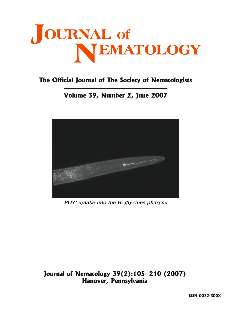Sukno, S.A, McCuiston, J., Wong, M.Y., Wang, X.H., Thon, M.R., Hussey, R., Baum, T., Davis, E. 2007. Journal of Nematology 39:145-152. COVER IMAGE
Abstract:
The introduction of a double-stranded RNA (dsRNA) into an organism to induce sequence-specific RNA interference (RNAi) of a target transcript has become a powerful technique to investigate gene function in nematodes and many organisms. Data provided here indicate that the inclusion of 1-2 mM spermidine and 50 mM octopamine and a 24 hr incubation period of nematodes in double-standard RNA (dsRNA) soaking solutions resulted in a considerable increase in the percentage of nematodes that ingested dsRNA as compared to previous reports. This modified dsRNA soaking method was coupled with quantitative real-time RT-PCR (qRT-PCR) analyses to assess the potential silencing of the Heterodera glycines parasitism gene transcripts Hg pel-I and Hg-4E02 that are expressed within the esophageal gland cells of preparasitic H. glycines J2. The Hg-pel-I transcript was most efficiently silenced with one dsRNA construct (ds267) at the highest dsRNA soaking concentration of 5.0 mg/ml, while the Hg-4E02 transcript was more efficiently silenced at the 2.5 mg/ml dsRNA concentration as compared to 5.0 mg/ml. A dsRNA construct (ds285) complementary to a different sequence within the Hg-pel-I transcript than construct ds267 induced only minimal silencing of the Hg-pel-I transcript at 2.5 mg/ml. The results suggest that both dsRNA concentration and sequence relative to the transcript targeted are critical for maximizing potential RNAi effects in parasitic nematodes.
PDF: Sukno et al 2007

